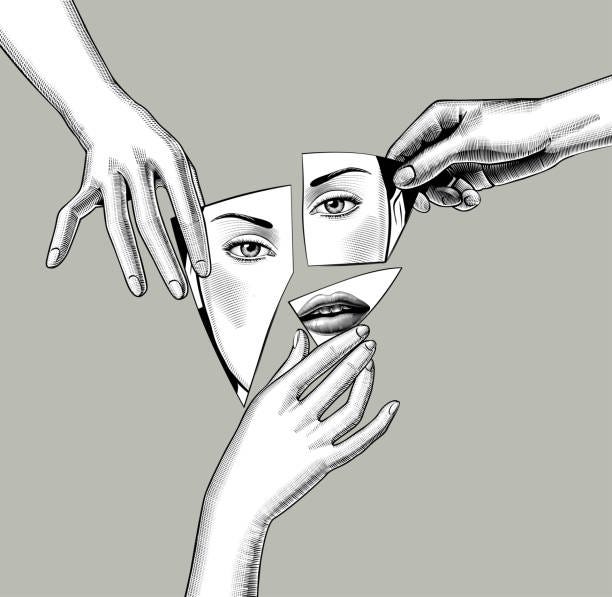In battle with the self
Discovering and protecting who you really are
In this post, there is one mention of eating disorders so please read with care and caution and if you want to skip this week’s newsletter that’s completely okay.
Who am I? Am I who I’ve always been? Is my digital self part of me or something different?
When I was first in therapy in 2020, I was struggling enormously with my self of sense. In many ways I still am. Back then, I found it debilitating to imagine that different versions of me, or ‘fragments’ as I used to refer to them then, could exist out there and in the minds of other people. What I realise now about why it became so overwhelming is that I could not state, defend, make claim or validate a single version of who I was even to myself. I lacked the agency to say with conviction ‘I am this kind of a person’ or ‘I am a person who could be described as this’. Knowing that other people could disagree or see me in a different way prevented me from seeing all my selves as a whole.
I think it’s why I’ve struggled so much with online dating. The ‘digital version’ of my online dating self becomes a marketing campaign that has never felt entirely congruent or true. It had the power to make me question myself, or at the very least how I was being perceived. All the quirks, quips, tone and subtleties help us judge an interaction and whether we gel with a person. Things we struggle to conceive of behind a screen.
Since the C-word of 2020 studies have taken place to assess the impact of increases in screen time, particularly in work environments. Research shows that increased digital communication results in decreased satisfaction. The University of California at Irvine, M.I.T., and Microsoft also explored the impact of digital communication through heart-rate monitors of forty workers, which after almost two weeks, proved that subjects’ stress levels rose higher the longer they spent on e-mail. If technology has the power to make us identify with feeling stressed, then trying to reconcile our digital selves through digital communication with others can feel like a kind of fracturing.
My digital self consists of the images of me or the words I have written, like prompts on a dating profile or emails sent at work, that exist somewhere online. They are the ways my personality, behaviours and qualities are communicated. They never seem to show the whole picture. A digital self is also one that lives not in chronological order. Your digital self if not a linear line like your in-real-life self, who can easily divide past self from current self. You digital self is always every version of you to have ever existed. A Tweet from 2016 looks the same as one from last week. It’s trickier for people to conceptualize the passing of time and the changes that may come with it to who you are as a person here and now. Public opinions and acceptability around certain topics may shift, meaning that retroactive judgements can applied to online comments and statements that were held in the past. Creator Hannah Stella summed it up perfectly: “People will be like, ‘Well, you said this in 2018’. And I’m like, ‘OK, I don’t know, that b*tch was crazy!’”
Fears of cancel culture have limited people from feeling confident in putting “themselves out there” in all spheres of life and has also led to a wider depoliticisation of the younger generation. Our digital selves carry little room for error.
There is also a part of my in-real-life self that has a relationship not with my digital self, but with technology as a whole. One that, like digital communication, equally provides a sense of stress. I constantly feel like I am always being told off. That my “self” is someone who gets things wrong and doesn’t comply with the rules. The other day, I got a notification about a fine from my gym for not turning up to a swimming slot that I booked. I pay £40 a month for a membership and the time I’d booked wasn’t on a waitlist. I had an email from a gallery after I visited asking if I enjoyed my visit and immediately felt anxious. I am watched, surveilled and followed by technology. I find the notifications on my phone overwhelming. The little red dot alerts hover over all my apps to let me know just how many unread messages or emails I have staring back at me every time I go on my phone.
What we consume online has an even greater impact on our sense of self. For every hour that a nine or ten-year-old child stays on social media, there is a 62% chance they’ll develop an eating disorder the following year. Studies have cited the constant comparison to unattainable body ideals, the pressure to display the body for likes, and exposure to eating disorder content as the main contributing factors. TikTok trends have given rise to young women desiring soft-girl lives of leisure or hopes of becoming a tradwife. Online, who we are and who we might become is the commodity that’s up for sale and we’re buying straight into it.
So, who are you? Are you who you’ve always been? How much does your digital self feel like a fragmented version of your true self?




